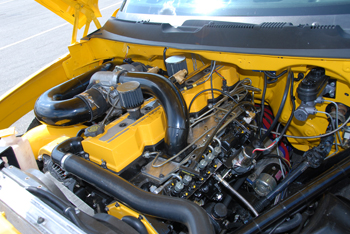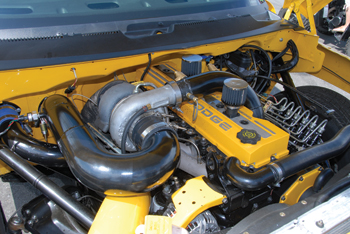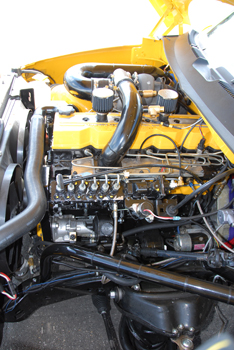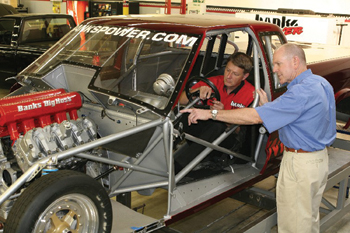spark plugs or ignition systems, and most of them don’t rev anywhere near as high as a gasoline-powered performance engine.
Most people associate diesel engines with truck and tractor pulling events, not traditional motorsports.
There are no diesel-powered NASCAR races or Indy cars. But, diesels are making inroads in other types of racing. Diesel-powered race cars and trucks are setting land speed records at Bonneville, winning endurance races at LeMans, and running over 200 mph in the quarter mile!
As one racer told us, “The first time we showed up at our local dragstrip with a diesel-powered truck, nobody took us seriously. But after the smoke cleared and everybody saw how fast the truck ran, they realized diesel drag racing is no joke. The fan base for diesel-powered drag racing has been growing ever since.”
So you may want to consider opportunities in diesel service and performance on your road to technician success. But, before you do, check out what experts in the field have said about this market:
Dan Scheid of Scheid Diesel (www.scheiddiesel.com) in Terre Haute, IN, says his shop has been involved with diesel performance work since the 1970s.
 “We started out doing modified fuel systems for tractor pullers, then expanded into engine work. As our customer base grew, we added more equipment, including a CNC machine to custom fabricate parts, and a 4,000 hp dyno for dialing in diesel engines.”
“We started out doing modified fuel systems for tractor pullers, then expanded into engine work. As our customer base grew, we added more equipment, including a CNC machine to custom fabricate parts, and a 4,000 hp dyno for dialing in diesel engines.”
Scheid has been racing a twin turbo 5.9L Cummins diesel powered dragster, which was the first diesel dragster to crack the 200 mph barrier. “We’re also building diesel drag racing engines for trucks. One of our customers has a diesel drag truck that is running in the low 9’s at 155 mph.”
Scheid says serious racers are spending a lot of money on their diesel performance engines, up to $60,000 or $70,000 dollars. Who wouldn’t want that kind of work?
“Any engine builder who is currently doing gasoline engine performance work could probably do diesel performance work too,” says Scheid. “You do have to learn about diesel fuel systems and how to correctly set up the injection pump, injectors and turbo. But the machine work you do on the block, heads and other internal parts are pretty much the same as any other performance engine.”
Scheid says that many diesel performance engines are running 130 to 180 psi of boost pressure. When you modify a stock engine to produce significantly more power, you also have to increase the flow capacity of the fuel system.
Scheid says he has modified a 12-cylinder mechanical injection pump so that the output for two cylinders can be routed to a single cylinder to double the fuel delivery. He also modifies the injectors by increasing the number and size of the nozzle orifices. Stronger fuel lines are also a must to handle higher fuel pressures.
Scheid says the engines he builds are designed to run on diesel only. The rules for most pulling events do not allow power adders such as propane, alcohol or nitrous oxide, but on the dragstrip, power adders may be legal. Most diesel engines are allowed to run water injection and/or an intercooler.

Taking it to the Streets
There are also ample opportunities to do diesel performance modifications for the street. It’s fairly easy to tweak the turbo and squeeze an extra 100 or more horsepower out of an engine without sacrificing fuel economy or everyday driveability. To maintain good driveability and throttle response, you want the turbo to spool up quickly and provide good low end torque.
Most street-driven diesel trucks are going to develop peak power between 1,800 and 3,200 rpm. Depending on how the truck is geared, a drag truck may be set up to run at a somewhat higher rpm. But it doesn’t take a lot of revs to make a lot of torque with a diesel.
Lenny Reed of Dynomite Diesel Performance, Monroe, WA, (www.dynomitediesel.com) said diesel engines in street trucks run best with a camshaft that develops a lot of cylinder pressure and a broad torque band. Reed drag races a Cummins-powered truck that develops 950 hp and runs in the mid-10s.
A high lift, long duration cam that typically produces a lot of high rpm power in a naturally aspirated gasoline engine would be the wrong grind for a diesel.
A diesel is a compression ignition engine, so valve overlap must be limited to keep pressures high in the cylinders at low rpm. Also, piston-to-valve clearances are limited, so there’s not much room for increasing valve lift. Because of this, the camshaft has to work with the turbo to create power and torque where the engine can use it. The key to realizing performance gains in a diesel engine is tuning the injector for the best timing, and correctly sizing the turbo.
Craig Johnson of Big Power Diesel (www.bigpowerdiesel.com) in Lancaster, CA, is another diesel engine builder who specialized in Cummins engines. He builds modified engines for both pulling and drag racing (though pulling is not as popular on the West Coast as it is in the Midwest).
“One of our customers has a Dodge truck built for sled pulling that produces about 1,000 hp with a single turbo and mechanical fuel injection system. The engine launches at about 5,000 rpm, and is connected to a single forward gear drop box.”
Johnson says anybody who is serious about pulling eventually builds a truck that is a dedicated puller rather than a dual-purpose street driven truck. The kind of engine and drivetrain modifications that are needed to make a puller competitive are not the type of modifications you would want on the street.
“Somebody who might spend $1,000 to $1,500 for some typical street performance modifications can still get good fuel economy and driveability. But, if you want to be competitive on a dragstrip or at a pulling event, you need an engine and a vehicle that is purpose-built. Some of these guys will spend $45,000 to $55,000 or more on their engines alone.”
From Hobby to Habit
One of the many Midwestern diesel engine builders is Van Hasley of Hasley Machine
(http://haisleymachine.com) in Fairmont, IN. Hasley has been doing diesels since 1985. He initially got involved in performance diesel work as a hobby, but it quickly grew into a fulltime business. He now specializes in B-Series Cummins engines for both drag racing and pulling.
“One of the limitations of the stock Cummins block is that it can split in two when you push it too far. So we had LSM in Waterford, MI, make us some billet steel blocks, and that solved our problem.”
Hasley says his little shop in the cornfields of rural Indiana has earned a national reputation for building highly competitive engines. One of our customers won the National Tractor Pullers Association (NTPA) points competition. We also won the prostock division of the Central Ohio Truck & Tractor Pullers title.
Hasley blueprints and assembles the engines he builds in-house, but uses a machine shop in Muncie, IN, to perform the actual engine machine work.
He uses ZZ Custom Fabrication in Wichita Falls, TX, do rework his cylinder heads and build custom intake manifolds. When he’s done, a 360-cid Cummins diesel engine may produce as much as 2,200 hp depending on how the turbos are set up. Engines may have one to three turbos, depending on the application.
The money that people are putting into these engines can really add up. Hasley says some of his customers are spending $30,000 to as much as $80,000 for a professionally competitive engine. In addition, they may spend $13,000 to $15,000 on the fuel system, and another $15,000 to $20,000 for turbochargers.
Nick McCormick of McCormick Diesel (www.mccormickdiesel.com) in Stewardson, IL, specializes in modifying and building International Harvester engines for tractor pulling.
He takes a stock 466 cubic inch engine that is rated at 125 hp, increases its displacement to 640 to 672 cid (depending on what the customer wants), and increased its power output to as much as 3,000 hp! These type of modifications require reworking or replacing almost everything.
The block is reworked to improve strength, the stock crankshaft is replaced with a custom billet stroker crank, and the heads and valvetrain are reworked to rev higher (up to 6,500 rpm) and flow more air.
McCormick says his family’s shop has been involved with tractor pulling since 1968. “We started out as a typical diesel shop, doing rebuilds and overhauls. Now, probably 60% to 80% of our business is diesel performance work. Our customers have won national championships as well as local events.”
McCormick says improvements in turbo designs in recent years have allowed significant power gains. “Emissions requirements have really been pushing the envelop for turbo development, so that is really helping our business.”

Greg Young of ZZ Custom Fabrication (http://zzcustomfabrication.com) in Wichita Falls, TX, says he got started in diesel performance work by building custom oil pans and valve covers for customers. From there, he moved on to building custom stainless steel intake manifolds, and eventually into reworking cylinder heads.
“Stock diesel heads are not designed for high speed performance, so there is a lot of room for improvement. A stock port might only flow 175 cfm (cubic feet per minute). That’s perfect for a low speed, low power stock diesel engine, but not a performance engine. By porting the head, and reworking the valves and seats, we can increase airflow to 270 cfm or more depending on what the customer wants.”
Young says he reworks a lot of 4-valve Cummins and Duramax heads.
There’s not much room on these heads to increase valve size, so most of the work goes into reshaping the ports to optimize airflow. Young says on some heads, he actually creates some combustion chambers so the head will breathe better (most diesel heads are flat with the combustion chamber located in the piston).
One tip for diesel engine builders, says Young, is to use stronger pushrods, especially for the exhaust valves. “There is a lot of exhaust pressure in a turbo diesel engine, which can result in bent exhaust pushrods or exhaust valve float at high engine speeds.
Young says he sees a bright future for diesel racing. “A customer can build an 800 hp big block Chevy for the street or strip that probably won’t last over 20,000 miles before you have to tear it down and redo it. And the fuel economy would not be very good. For the same money, you can build an 800 horsepower turbo diesel engine that will last 150,000 miles and deliver great fuel economy.
“We have a customer who put a modified Duramax diesel engine in a Mustang. The car runs 9.20 in the quarter mile, but can be driven on the street and gets 38 miles per gallon. That’s the future in performance engine building as I see it,” said Young.
In spite of the money that is being put into some of these engines, diesel racing is not a high dollar sport as far as prize money paid to the racers is concerned. Hasley says the prize money for a win even at a national event seldom exceeds $1,000. The people who are spending this kind of money on diesel
racing are doing it because they enjoy the sport, not for sponsorship money or big purses.
Interested in More Diesel Articles?
Visit underhoodservice.com and search Bob McDonald.
McDonald, who owns Atlantic Engines (http://atlanticengines.com) in Granite Falls, NC, specializes in diesel performance and has written articles on light-duty diesel engines, as well as a book on the Ford Power Stroke.











